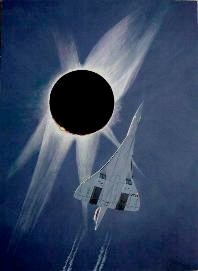Solar eclipse maps from 1971 to 1980
Sources
The maps from the American Ephemeris and Nautical Almanac from 1971 to 1980 are either scanned from the collection of Michael Zeiler or from holdings at the Federal Depository Library in Albuquerque, N.M.
The eclipse maps from the Royal Astronomical Society of Canada and Manitoba Planetarium can be found by searches on the NASA Astrophysics Data System at http://articles.adsabs.harvard.edu.
The 1972 map of the path of the cruise ship Olympia is courtesy of Bill Kramer.
The 1972 and 1973 eclipse maps from the National Science Foundation were found at http://www.archive.org/details/solareclipse1970nati.
Video of the 1979 eclipse can be found at http://www.youtube.com/watch?v=gAacZoIJUN0 and http://www.youtube.com/watch?v=MWIFqoldhfU.
In 1973, a superlative event in the history of eclipse observation took place when the Concorde super-sonic aircraft intercepted a total solar eclipse over Africa for an amazing . An abstract of the article in Nature, 09 November 1973, “Eclipse Flight of Concorde 001” by J. Beckman et. al. states:
“On June 30, 1973, Concorde 001 intercepted the path of a solar eclipse over North Africa, Flying at Mach 2.05 the aircraft provided seven observers from France, Britain and the United States with 74 min of totality bounded by extended second (7 min) and third (12 min) contacts. The former permitted searches for time variations of much longer period than previously possible and the latter provided an opportunity for chromospheric observations of improved height resolution. The altitude, which varied between 16,200 and 17,700 m, freed the observations from the usual weather problems and greatly reduced atmospheric absorption and sky noise in regions of the infrared.”
Because of the retirement of the Concorde fleet after a tragic crash in 2000, this eclipse duration record is not likely to be surpassed for many years. The story of this eclipse flight is in Los Alamos Science and can be found at http://library.lanl.gov/cgi-bin/getfile?02-02.pdf


Many solar eclipses are most favorably observed from sea. While a ship is not ideal for capturing a photographic record of the eclipse, it does have the advantage of seeking a region at sea with favorable weather prospects along with some mobility on eclipse day. This map describes the journey of an early eclipse cruise of the Olympic to spy the eclipse of July 10, 1972.
